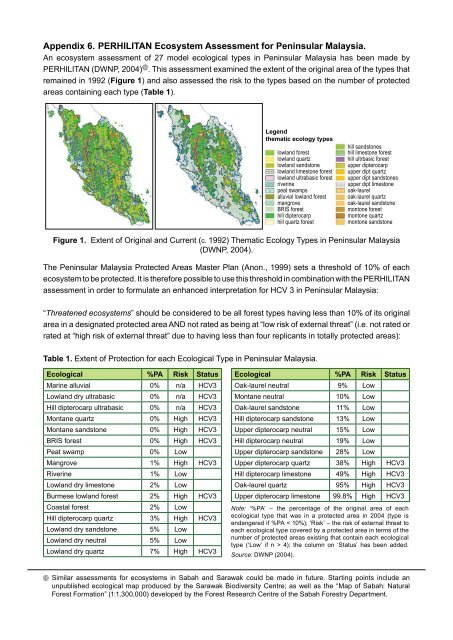(HCVF) Toolkit for Malaysia - HCV Resource Network
(HCVF) Toolkit for Malaysia - HCV Resource Network
(HCVF) Toolkit for Malaysia - HCV Resource Network
You also want an ePaper? Increase the reach of your titles
YUMPU automatically turns print PDFs into web optimized ePapers that Google loves.
Appendix 6. PERHILITAN Ecosystem Assessment <strong>for</strong> Peninsular <strong>Malaysia</strong>.<br />
An ecosystem assessment of 27 model ecological types in Peninsular <strong>Malaysia</strong> has been made by<br />
16<br />
PERHILITAN (DWNP, 2004) . This assessment examined the extent of the original area of the types that<br />
remained in 1992 (Figure 1) and also assessed the risk to the types based on the number of protected<br />
areas containing each type (Table 1).<br />
Legend<br />
thematic ecology types<br />
lowland <strong>for</strong>est<br />
lowland quartz<br />
lowland sandstone<br />
lowland limestone <strong>for</strong>est<br />
lowland ultrabasic <strong>for</strong>est<br />
riverine<br />
peat swamps<br />
alluvial lowland <strong>for</strong>est<br />
mangrove<br />
BRIS <strong>for</strong>est<br />
hill dipterocarp<br />
hill quartz <strong>for</strong>est<br />
hill sandstones<br />
hill limestone <strong>for</strong>est<br />
hill ultrbasic <strong>for</strong>est<br />
upper dipterocarp<br />
upper dipt quartz<br />
upper dipt sandstones<br />
upper dipt limestone<br />
oak-laurel<br />
oak-laurel quartz<br />
oak-laurel sandstone<br />
montone <strong>for</strong>est<br />
montone quartz<br />
montone sandstone<br />
Figure 1. Extent of Original and Current (c. 1992) Thematic Ecology Types in Peninsular <strong>Malaysia</strong><br />
(DWNP, 2004).<br />
The Peninsular <strong>Malaysia</strong> Protected Areas Master Plan (Anon., 1999) sets a threshold of 10% of each<br />
ecosystem to be protected. It is there<strong>for</strong>e possible to use this threshold in combination with the PERHILITAN<br />
assessment in order to <strong>for</strong>mulate an enhanced interpretation <strong>for</strong> <strong>HCV</strong> 3 in Peninsular <strong>Malaysia</strong>:<br />
“Threatened ecosystems” should be considered to be all <strong>for</strong>est types having less than 10% of its original<br />
area in a designated protected area AND not rated as being at “low risk of external threat” (i.e. not rated or<br />
rated at “high risk of external threat” due to having less than four replicants in totally protected areas):<br />
Table 1. Extent of Protection <strong>for</strong> each Ecological Type in Peninsular <strong>Malaysia</strong>.<br />
Ecological %PA Risk Status<br />
Marine alluvial 0% n/a <strong>HCV</strong>3<br />
Lowland dry ultrabasic 0% n/a <strong>HCV</strong>3<br />
Hill dipterocarp ultrabasic 0% n/a <strong>HCV</strong>3<br />
Montane quartz 0% High <strong>HCV</strong>3<br />
Montane sandstone 0% High <strong>HCV</strong>3<br />
BRIS <strong>for</strong>est 0% High <strong>HCV</strong>3<br />
Peat swamp 0% Low<br />
Mangrove 1% High <strong>HCV</strong>3<br />
Riverine 1% Low<br />
Lowland dry limestone 2% Low<br />
Burmese lowland <strong>for</strong>est 2% High <strong>HCV</strong>3<br />
Coastal <strong>for</strong>est 2% Low<br />
Hill dipterocarp quartz 3% High <strong>HCV</strong>3<br />
Lowland dry sandstone 5% Low<br />
Lowland dry neutral 5% Low<br />
Lowland dry quartz 7% High <strong>HCV</strong>3<br />
Ecological %PA Risk Status<br />
Oak-laurel neutral 9% Low<br />
Montane neutral 10% Low<br />
Oak-laurel sandstone 11% Low<br />
Hill dipterocarp sandstone 13% Low<br />
Upper dipterocarp neutral 15% Low<br />
Hill dipterocarp neutral 19% Low<br />
Upper dipterocarp sandstone 28% Low<br />
Upper dipterocarp quartz 38% High <strong>HCV</strong>3<br />
Hill dipterocarp limestone 49% High <strong>HCV</strong>3<br />
Oak-laurel quartz 95% High <strong>HCV</strong>3<br />
Upper dipterocarp limestone 99.8% High <strong>HCV</strong>3<br />
Note: ‘%PA’ – the percentage of the original area of each<br />
ecological type that was in a protected area in 2004 (type is<br />
endangered if %PA < 10%); ‘Risk’ – the risk of external threat to<br />
each ecological type covered by a protected area in terms of the<br />
number of protected areas existing that contain each ecological<br />
type (‘Low’ if n > 4); the column on ‘Status’ has been added.<br />
Source: DWNP (2004).<br />
16<br />
Similar assessments <strong>for</strong> ecosystems in Sabah and Sarawak could be made in future. Starting points include an<br />
unpublished ecological map produced by the Sarawak Biodiversity Centre; as well as the “Map of Sabah: Natural<br />
Forest Formation” (1:1,300,000) developed by the Forest Research Centre of the Sabah Forestry Department.

















